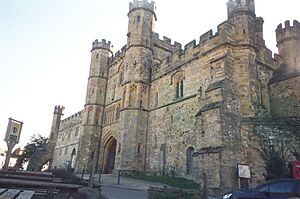Walter de Luci facts for kids
Quick facts for kids Walter de Luci |
|
|---|---|

Main Gate of Battle Abbey
|
|
| Religion | Catholic |
| Personal | |
| Born | 1103 (or 1091) Lucé, Normandy |
| Died | 21 June 1171 Battle, East Sussex |
| Senior posting | |
| Based in | England |
| Title | Abbot of Battle |
| Period in office | 1139–1171 |
| Predecessor | Warner |
| Successor | Odo |
Walter de Luci was an important leader at Battle Abbey in England. He was known as the Abbot, which is like the head of a monastery. Walter also had a famous brother, Richard de Luci, who was the King's top judge, called the Chief Justiciar of England.
Contents
Walter de Luci's Early Life and Role
Before becoming Abbot, Walter was a Benedictine monk. He lived and studied at Lonlay-l'Abbaye, a monastery in Normandy.
In 1139, Walter was chosen to be the Abbot of Battle Abbey. This important monastery was located in Sussex, England. He officially became Abbot on January 8, 1139. Walter remained the Abbot until his death on June 21, 1171.
A Big Dispute with the Bishop
While Walter was Abbot, he got into a major disagreement. This argument was with Hilary, who was the bishop of Chichester. Bishop Hilary believed he had power over Battle Abbey.
Battle Abbey was special because it was started by King William I of England. It was considered a "royal foundation." This meant it had a special connection to the king. The Abbey also acted like an eigenkirche, which means it was owned by a powerful family or the king, not directly by the church hierarchy.
The Bishop's Orders
Bishop Hilary felt that Battle Abbey should follow his rules. He even got orders from two different Popes, Eugene III and Hadrian IV. These orders told Battle Abbey to obey the bishop.
However, Battle Abbey had never received a special paper from the Pope. This paper, called a "papal exemption," would have freed them from the bishop's control. Instead, they relied on their royal founding.
Taking the Case to the King
In 1157, Walter de Luci decided to take the problem to King Henry II of England. They met at a big meeting, called a council, in Colchester.
Walter showed the King important documents. These included the original paper from King William I, who founded the Abbey. He also showed a paper from King Henry I of England, who was King Henry II's grandfather. Both papers said that the Abbey was free from the church's control. King Henry II agreed that these papers were real.
The King's Decision
Bishop Hilary argued that only a papal exemption could free a monastery. He said Battle Abbey did not have one. But King Henry II did not like this argument. He felt it challenged his own royal power.
Thomas Becket, who was the King's chancellor at the time, also spoke against Bishop Hilary. The King decided in favor of Battle Abbey. This showed that the King's power was very important.

